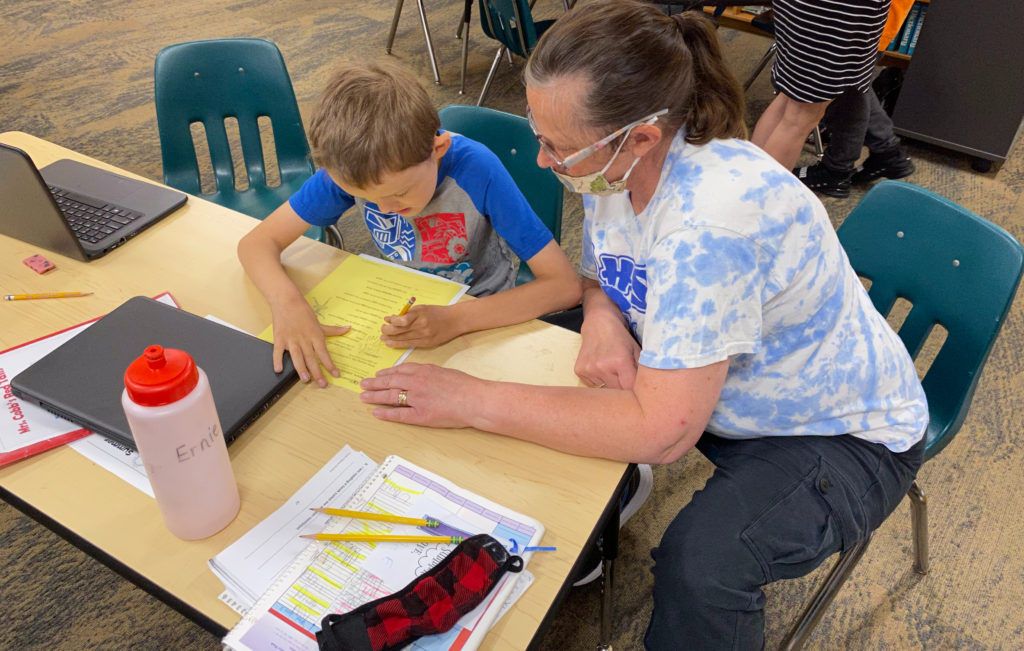Paraeducators perform critical functions for little pay

QUINCY — Anne Meyer remembers why she became a paraeducator.
She had been teaching physical education classes at St. Francis School, but when her daughter, Grace, started kindergarten at Washington School, Meyer changed her teaching role.
Fourteen years later, with Grace now out of high school, Meyer knows why she continues as a paraeducator in Erica Cobb’s third-grade classroom at Iles Elementary School.
“Having a daughter with special needs, I’ve learned how important it is to help students who struggle or have disabilities,” she said. “I help them feel included, or I can help them get some work done.”
Then with a smile, Meyer added, “I definitely don’t do it for the money.”
Minimum wage to hit $15 an hour in 2025
Yet the money will become a big factor in how many paraeducators will be employed by the Quincy School District in the future.
Paraeducator is short for paraprofessional educator and is also known as para-pro, para, instructional assistant, educational assistant, teacher’s aide or classroom assistant. Paraeducators are generally responsible for specialized or concentrated assistance for elementary or secondary level students.
A first-year paraeducator in Quincy is paid minimum wage, which is $11 an hour in Illinois. However, Gov. J.B. Pritzker signed legislation that calls for the minimum wage to increase $1 every year until it reaches $15 an hour in 2025.
“It’s going to be a very large impact, considering that they’re unfunded mandates,” said Ryan Whicker, chief of business operations for the Quincy School District. “They’re requiring us to do that, and they’re not giving us any additional funds to do so. If local property taxes don’t increase at a significant rate, or state or federal funding doesn’t increase to cover that, then you’re looking at reductions and some type of expenses (reductions) to meet those mandates.”
Asked if that means a reduction in the workforce, Whicker replied, “I mean, it could. It could mean a lot of different things. Possibly some resources. Everything’s kind of on the table. We would look at things first that would least impact instruction, and then you would have to look at personnel, because it’s 80 percent of our budget.
“The last thing we want to do is reduce the workforce.”

Paraeducators help students with variety of needs
Iles principal Brad Funkenbusch said paraeducators work with students with a variety of needs.
He said program paraeducators work in cross categorical (self-contained special education) classrooms and service the majority of the students in the room. Access paraeducators may help facilitate learning with two or three students. One-on-one paraeducators work with individual children with varying needs. Students must have an individualized education program (IEP) to be eligible to have a paraeducator.
“They could have physical needs. They could have cognitive needs,” Funkenbusch said. “We have paraeducators (at Iles) who help with everything from helping a child with mobility issues to helping a child stay on task and focus. They try to support students so they are able to learn the best they can.”
Iles had 12 paraeducators for the 2020-21 school year, and the Quincy School District had 139. Paraeducators work seven hours a day for 181 school days each year. A paraeducator with no college education in their first year of teaching would have an annual salary of $13,937, while also receiving full medical benefits and a pension with the Illinois Municipal Retirement Fund.
A first-year paraeducator with 60 hours of college classes started the 2020-21 school year making a little more than $12 an hour for a salary of a little more than $15,000.
“We get a lot of people who are retired from other positions,” said Diana Gedstad, who recently retired as a paraeducator at Lincoln-Douglas School. She also stepped down after the most recent contract negotiations after representing 106 paraeducators in the district as the president of the Educational Support Personnel subgroup of the Quincy Federation of Teachers Local 809.
“Either they like to get the benefits or they like the insurance. We get sick days. We get off during the summer. Granted, we don’t make the biggest pay, and you don’t get the younger people because they’d rather go on and become a teacher. There are people who would be a para if the pay was better. But if you can afford to make the pay you’re getting and be off all summer long to be with your kids, it works for some people.”
Life with fewer paraeducators: ‘I don’t want to think about it’
Funkenbusch said he has lost paraeducators because they found jobs that paid more. Two paraeducator positions at Iles were not filled during this past school year.
Funkenbusch says the goal of a paraeducator is to “work themselves out of a job.”
“We want to help facilitate independence for every kid that we’re working with, because we want to give them just the right amount of support without doing too much for them,” he said. “We want to support them enough that they’re able to be successful and they eventually no longer need the support.”
Asked what life would be like at Iles with fewer educators because of budgetary reasons, Funkenbusch said, “I don’t want to think about that. If you can’t pay somebody to be there, you look at ways to be creative. Maybe you have to group students differently and have paras work with more than students in a classroom. It would definitely be tough. We run it about as efficiently as we can at this point.”
Cobb says Earnie Bence, the student Meyer works with in her classroom, gets more work done and more out of his school day when Meyer is with him.
“Just having an extra person in the room makes a huge difference, and not just with the student she works with but with all of the kids,” Cobb said. “If we had to have fewer paras, it would not only be unfair to the students who need the paras but also to the students in your classroom, because I’m going to have to spend that much more time with one student, taking away time from the other kids. And nobody wants that.”
Miss Clipping Out Stories to Save for Later?
Click the Purchase Story button below to order a print of this story. We will print it for you on matte photo paper to keep forever.

